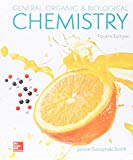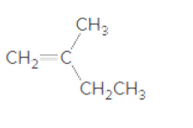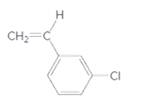
Interpretation:
The structure of polymer formed on polymerizing following compound should be determined:

Concept Introduction:
Based on type of polymers, polymerization reaction can be two types; addition polymerization and condensation polymerization. The addition polymerization occurs between monomer units with unsaturated bonds between carbon atoms. For example; polymerization of
Condensation polymerization occurs with those monomers which have some
Interpretation:
The structure of polymer formed on polymerizing following compound should be determined:

Concept Introduction:
Polymers are macromolecules which are composed of a large number of small repeating units. This repeating units are known as monomers and the process of formation of polymers from monomer units is known as polymerization.
Based on type of polymers, polymerization reaction can be two types; addition polymerization and condensation polymerization. The addition polymerization occurs between monomer units with unsaturated bonds between carbon atoms. For example; polymerization of alkene leads to formation of polyalkenes.
Condensation polymerization occurs with those monomers which have some functional groups like −OH, -COOH, -NH2 etc. These polymerizations occur with elimination of small molecules such as H2O, CO, and CO2 etc.
Interpretation:
The structure of polymer formed on polymerizing following compound should be determined:

Concept Introduction:
Polymers are macromolecules which are composed of a large number of small repeating units. This repeating units are known as monomers and the process of formation of polymers from monomer units is known as polymerization.
Based on type of polymers, polymerization reaction can be two types; addition polymerization and condensation polymerization. The addition polymerization occurs between monomer units with unsaturated bonds between carbon atoms. For example; polymerization of alkene leads to formation of polyalkenes.
Condensation polymerization occurs with those monomers which have some functional groups like −OH, -COOH, -NH2 etc. These polymerizations occur with elimination of small molecules such as H2O, CO, and CO2 etc.
Want to see the full answer?
Check out a sample textbook solution
Chapter 13 Solutions
Loose Leaf for General, Organic and Biological Chemistry with Connect 2 Year Access Card
- Which polymer has a carboxylic acid functional group? A) Nomex B) Polyvinyl acetate C) Rubber D) Polyacrylate E) Polyethylene glycolarrow_forwardWhat is the structure of the monomer from which the following polymer is made? Select one O a. H2C CH, O b. HC-CH OC. Oe. CH3arrow_forwardSubject :- Chemistryarrow_forward
- What polymer is formed in this reaction, using polymer notation?arrow_forwardWhich polymer has an alkene functional group? A) Nomex B) Polyvinyl acetate C) Rubber D) Polyacrylate E) Polyethylene glycolarrow_forwardA particularly strong and rigid polyester used for electronic parts is marketed under the trade name Glyptal. It is a polymer of terephthalic acid and glycerol. Draw a segment of the polymer and explain why it is so strong.arrow_forward
- Drawing the Structure of a Polymer Formed from a Monomer What polymer is formed when CH2=CHCO2H (acrylic acid) is polymerized to form poly(acrylic acid)?arrow_forwarddacron is the brand name for the polymer that is made from ethane-1,2-diol and benzene-1,4-dicarboxylic acid. what is the name for the linkages that join the monomers togetherarrow_forwardThe monomers -(CH2)-C-OH and H2N- -NH2 но- would react with each other to form a polycarbonate a polyamide a polyesterarrow_forward
- What polymers are formed from each monomer?arrow_forwardPolypropene results from the polymerization of H H A. CH-C B. CH-C c. CH-c ĆN D. CH-C E. CH-C Multiple Choicearrow_forwardGlyptal® resin makes a strong, solid polymer matrix for electronic parts. Glyptal is made from terephthalic acid and glycerol. Draw the structure of Glyptal, and explain its remarkable strength and rigidity.arrow_forward
 General, Organic, and Biological ChemistryChemistryISBN:9781285853918Author:H. Stephen StokerPublisher:Cengage Learning
General, Organic, and Biological ChemistryChemistryISBN:9781285853918Author:H. Stephen StokerPublisher:Cengage Learning Organic And Biological ChemistryChemistryISBN:9781305081079Author:STOKER, H. Stephen (howard Stephen)Publisher:Cengage Learning,Chemistry: Matter and ChangeChemistryISBN:9780078746376Author:Dinah Zike, Laurel Dingrando, Nicholas Hainen, Cheryl WistromPublisher:Glencoe/McGraw-Hill School Pub Co
Organic And Biological ChemistryChemistryISBN:9781305081079Author:STOKER, H. Stephen (howard Stephen)Publisher:Cengage Learning,Chemistry: Matter and ChangeChemistryISBN:9780078746376Author:Dinah Zike, Laurel Dingrando, Nicholas Hainen, Cheryl WistromPublisher:Glencoe/McGraw-Hill School Pub Co ChemistryChemistryISBN:9781305957404Author:Steven S. Zumdahl, Susan A. Zumdahl, Donald J. DeCostePublisher:Cengage Learning
ChemistryChemistryISBN:9781305957404Author:Steven S. Zumdahl, Susan A. Zumdahl, Donald J. DeCostePublisher:Cengage Learning Chemistry: An Atoms First ApproachChemistryISBN:9781305079243Author:Steven S. Zumdahl, Susan A. ZumdahlPublisher:Cengage Learning
Chemistry: An Atoms First ApproachChemistryISBN:9781305079243Author:Steven S. Zumdahl, Susan A. ZumdahlPublisher:Cengage Learning





